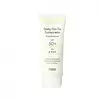What's inside
What's inside
 Key Ingredients
Key Ingredients

 Benefits
Benefits

 Concerns
Concerns

No concerns
 Ingredients Side-by-side
Ingredients Side-by-side

Water
Skin ConditioningButyloctyl Salicylate
Skin ConditioningDibutyl Adipate
EmollientPropanediol
SolventButylene Glycol
HumectantBis-Ethylhexyloxyphenol Methoxyphenyl Triazine
Skin ConditioningEthylhexyl Triazone
UV AbsorberDicaprylyl Carbonate
EmollientTitanium Dioxide
Cosmetic ColorantDiethylamino Hydroxybenzoyl Hexyl Benzoate
UV FilterHydrogenated Poly(C6-14 Olefin)
Emollient1,2-Hexanediol
Skin ConditioningCentella Asiatica Extract
CleansingPolyglyceryl-2 Stearate
EmulsifyingAluminum Hydroxide
EmollientGlyceryl Stearate
EmollientStearyl Alcohol
EmollientSodium Polyacrylate
AbsorbentStearic Acid
CleansingPolyhydroxystearic Acid
EmulsifyingBehenyl Alcohol
EmollientPolymethylsilsesquioxane
Ethylhexyl Stearate
EmollientAmmonium Acryloyldimethyltaurate/Vp Copolymer
Caprylyl Glycol
EmollientTrideceth-6
EmulsifyingEthylhexylglycerin
Skin ConditioningXanthan Gum
EmulsifyingMadecassoside
AntioxidantAsiaticoside
AntioxidantAsiatic Acid
Skin ConditioningMadecassic Acid
Skin ConditioningWater, Butyloctyl Salicylate, Dibutyl Adipate, Propanediol, Butylene Glycol, Bis-Ethylhexyloxyphenol Methoxyphenyl Triazine, Ethylhexyl Triazone, Dicaprylyl Carbonate, Titanium Dioxide, Diethylamino Hydroxybenzoyl Hexyl Benzoate, Hydrogenated Poly(C6-14 Olefin), 1,2-Hexanediol, Centella Asiatica Extract, Polyglyceryl-2 Stearate, Aluminum Hydroxide, Glyceryl Stearate, Stearyl Alcohol, Sodium Polyacrylate, Stearic Acid, Polyhydroxystearic Acid, Behenyl Alcohol, Polymethylsilsesquioxane, Ethylhexyl Stearate, Ammonium Acryloyldimethyltaurate/Vp Copolymer, Caprylyl Glycol, Trideceth-6, Ethylhexylglycerin, Xanthan Gum, Madecassoside, Asiaticoside, Asiatic Acid, Madecassic Acid
Water
Skin ConditioningZinc Oxide
Cosmetic ColorantTitanium Dioxide
Cosmetic ColorantIsododecane
EmollientNeopentyl Glycol Diheptanoate
EmollientButylene Glycol
HumectantPropanediol
SolventDioctyldodeceth-5 Lauroyl Glutamate
EmollientAlumina
AbrasiveAmmonium Acryloyldimethyltaurate/Vp Copolymer
Caprylhydroxamic Acid
Glyceryl Stearate
EmollientSteareth-21
CleansingSteareth-2
EmulsifyingPEG-100 Stearate
Phenoxyethanol
PreservativeMethylpropanediol
SolventSimethicone
EmollientMethyl Gluceth-20
HumectantTriethanolamine
BufferingCarbomer
Emulsion StabilisingAscorbyl Tetraisopalmitate
AntioxidantTocopheryl Acetate
AntioxidantXanthan Gum
EmulsifyingSodium Hyaluronate
HumectantSaxifraga Sarmentosa Extract
Skin ConditioningWater, Zinc Oxide, Titanium Dioxide, Isododecane, Neopentyl Glycol Diheptanoate, Butylene Glycol, Propanediol, Dioctyldodeceth-5 Lauroyl Glutamate, Alumina, Ammonium Acryloyldimethyltaurate/Vp Copolymer, Caprylhydroxamic Acid, Glyceryl Stearate, Steareth-21, Steareth-2, PEG-100 Stearate, Phenoxyethanol, Methylpropanediol, Simethicone, Methyl Gluceth-20, Triethanolamine, Carbomer, Ascorbyl Tetraisopalmitate, Tocopheryl Acetate, Xanthan Gum, Sodium Hyaluronate, Saxifraga Sarmentosa Extract
 Reviews
Reviews

Ingredients Explained
These ingredients are found in both products.
Ingredients higher up in an ingredient list are typically present in a larger amount.
Ammonium Acryloyldimethyltaurate/Vp Copolymer (let's call it AAVC for short) is a synthetically created polymer. It's used as a film-forming agent and used to thicken the consistency of products.
AAVC is able to increase the consistency and viscosity of products due to its large molecule size. It also prevents ingredients from separating.
Butylene Glycol (or BG) is used within cosmetic products for a few different reasons:
Overall, Butylene Glycol is a safe and well-rounded ingredient that works well with other ingredients.
Though this ingredient works well with most skin types, some people with sensitive skin may experience a reaction such as allergic rashes, closed comedones, or itchiness.
Learn more about Butylene GlycolGlyceryl Stearate is a mix of glycerin and stearic acid.
It is used to stabilize the mixing of water and oil ingredients. By preventing these ingredients from separating, it can help elongate shelf life. It can also help thicken the product's texture.
As an emollient, it helps soften skin and supports barrier-replenishing ingredients.
In cosmetics, Glyceryl Stearate is often made from vegetable oils or synthetically produced.
This ingredient may not be fungal-acne safe
Fun fact: The human body also creates Glyceryl Stearate naturally.
Learn more about Glyceryl StearatePropanediol is an all-star ingredient. It softens, hydrates, and smooths the skin.
It’s often used to:
Propanediol is not likely to cause sensitivity and considered safe to use. It is derived from corn or petroleum with a clear color and no scent.
Learn more about PropanediolTitanium dioxide is a mineral UV filter widely used in sunscreens and cosmetics.
It is one of only two UV filters officially classified as “mineral” by regulatory agencies, the other being zinc oxide.
Titanium dioxide provides broad-spectrum protection mostly in the UVB and UVAII range, with some protection in the UVAI range.
While its UVA protection isn’t as strong as zinc oxide’s, the difference is minor.
A common myth is that mineral UV filters reflect UV light. However, modern research shows titanium dioxide absorbs UV radiation like chemical filters (~95% absorption & 5% reflection).
Thanks to its non-irritating nature, titanium dioxide is suitable for sensitive, acne-prone, or redness-prone skin. It is unlikely to cause "eye sting" like other sunscreen ingredients.
A major drawback of this ingredient is its white cast and thick texture. This is why mineral sunscreens often leave a white cast and are less cosmetically elegant than chemical/hybrid sunscreens.
To improve white cast and spreadability, micronized or nano-sized titanium dioxide is often used.
There are ongoing concerns surrounding nano-titanium oxide's impact on marine ecosystems.
There is no conclusive evidence that any form of titanium oxide (or any other sunscreen ingredients) will cause harm to marine ecosystems or coral reefs. The science is still developing but many consumers are keeping a close eye on this issue.
Please note, many destinations have reef-safety sunscreen rules. For instance, the U.S. Virgin Islands advises all visitors to use non-nano mineral sunscreens.
Nano mineral sunscreens once raised safety concerns about absorption into skin.
Extensive research has shown that they do not penetrate healthy or damaged skin; they remain safely on the surface and the top layer of dead skin (stratum corneum).
You'll likely find titanium dioxide bundled with alumina, silica, or dimethicone. These ingredients help make titanium dioxide highly photostable; this prevents it from interacting with other formula components under UV light.
Learn more about Titanium DioxideWater. It's the most common cosmetic ingredient of all. You'll usually see it at the top of ingredient lists, meaning that it makes up the largest part of the product.
So why is it so popular? Water most often acts as a solvent - this means that it helps dissolve other ingredients into the formulation.
You'll also recognize water as that liquid we all need to stay alive. If you see this, drink a glass of water. Stay hydrated!
Learn more about WaterXanthan gum is used as a stabilizer and thickener within cosmetic products. It helps give products a sticky, thick feeling - preventing them from being too runny.
On the technical side of things, xanthan gum is a polysaccharide - a combination consisting of multiple sugar molecules bonded together.
Xanthan gum is a pretty common and great ingredient. It is a natural, non-toxic, non-irritating ingredient that is also commonly used in food products.
Learn more about Xanthan Gum